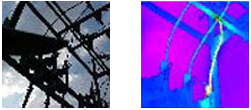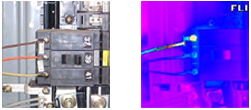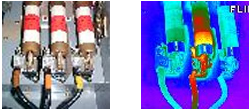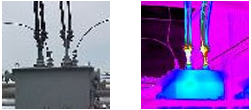Infrared Thermography Inspection Service




It’s a fact. Infrared thermography saves you time, saves you money, prevents fires, and even saves lives. It is by far the greatest form of nondestructive testing (NDT) ever devised for predictive maintenance (PdM) of electrical systems. A recent study performed by Hartford Steam Boiler concluded that effective infrared thermography programs performed by qualified companies average 400% Return on Investment. Add to this the safety aspects, and it becomes clear that any company that cares about its bottom line and safety program uses infrared thermography on a regular basis.
The National Fire Protection Association (NFPA) 70 B declares “a well-administered Electrical Preventative Maintenance program will reduce accidents, save lives, and minimize costly break downs and unplanned shutdowns of production equipment,” and recommends that “routine infrared inspections of energized electrical systems should be performed annually… more frequent infrared inspections, for example, quarterly or semi-annually, should be performed where warranted by loss experience, installation of new electrical equipment, or changes in environmental, operational, or load conditions.” Furthermore, these recommendations have been adopted as a standard by the Occupational Health and Safety Administration (OSHA). Additionally, many insurance companies are now offering substantial discounts to clients who subscribe to regular infrared thermography inspections as part of their PdM.
Why is it so effective? Increased resistance in electrical components can be caused by equipment fatigue, improper installation, loose connections, age, exposure to the elements, and normal wear and tear. This increased resistance also results in increased heat; combined, they are the primary cause for most electrical component failures. Infrared thermography allows us to see this heat through an infrared camera before any damage is visible with the naked eye. This gives you the advantage of correcting the problem in its early stages before it has devastating effects on people, buildings, or equipment.
Dyna Scan, founded in 1986, has a long standing tradition of providing the most comprehensive infrared thermography inspections throughout the country. All of our thermographers are Certified Thermographers, meeting or exceeding the guidelines of the American Society for Nondestructive Testing (ASNT)SNT-TC-1A. Our online reporting system is one of the most advanced and informative in the industry. It allows you to sort through multiple sites at once and to view results over time.




The problem above is from a substation for a large distillery. The environment is dirty and corrosive which often causes electrical anomalies. In this case a poor connection at the switch is causing a massive amount of heat to travel the length of the conductor. At the time of the inspection, the wire was corroded and the insulation was breaking down due to the intense heat. A failure would interrupt the entire operation of the distillery resulting in loss of product and expensive downtime that is difficult to calculate. It is safe to say that this problem alone paid for the infrared inspection many times over.
This anomaly represents a poor connection between the wire and the breaker. At the time of this picture the hot spot cannot be seen by the naked eye. Without corrective action, however, this problem is likely to lead to failure, destruction of equipment or a fire. By finding it now, in its infancy, the maintenance staff has time to schedule a repair and avoid the cost and danger of a breakdown.
The B-Phase load side fuse clip has a temperature of 181°F compared to the C-Phase load side, which is 119°F, giving a delta temperature of 62°F. This particular device is the main switch for a public elevator in a hospital. Failure is a definite safety issue. Because we caught this problem early, the hospital crew can safely shut down the elevator to public use and fix the problem avoiding a potentially serious and embarrassing situation.
The anomaly shown above was in the critical stage of deterioration at the time of these pictures. No visible damage could be seen with the human eye, but our infrared imager saved the plant from a probable power outage that would have lasted hours. This industrial customer potentially saved tens of thousands of dollars by being proactive.